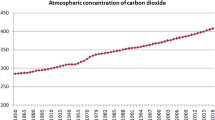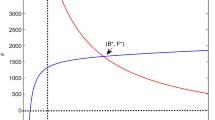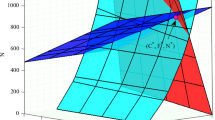Abstract
Global warming is a serious issue that affects the environment and mankind. The anthropogenic emissions of carbon dioxide, mainly due to fossil fuel burning and deforestation, are among the root cause of global warming. The goal of this work is to present a mathematical model to analyze the long-term impact of an integrated CO2 taxation-reforestation policy on the mitigation of atmospheric CO2 levels. It is assumed that carbon tax is applied to anthropogenic CO2 emissions and a part of the money generated by carbon taxation is invested to accelerate the reforestation programs. The stability theory of differential equations is applied to examine the qualitative behaviour of the system. Lyapunov stability theory is used to derive sufficient conditions under which the atmospheric carbon dioxide level gets stabilized. It is found that an increment in the deforestation rate coefficient above a threshold level leads to stability loss of interior equilibrium and generation of periodic orbits via Hopf-bifurcation. It is found that the amplitude of the oscillation cycles can be dampened on increasing the maximum efficiency of reforestation programs to increase the forest biomass and above a threshold value of the maximum efficiency of reforestation programs, the periodic oscillations die out. It is found that the seasonality in the application of reforestation efforts may lead to the generation of higher periodic solutions above a threshold level of deforestation rate, making it hard to predict and control the atmospheric CO2 level. The conditions for global attractivity of positive periodic solution of the seasonally forced model are discussed. Numerical simulation has been presented to illustrate the theoretical findings.

















Similar content being viewed by others
Data availability
All data generated or analysed during this study are included in this article.
References
IPCC, Climate Change 2014: Synthesis Report. Contribution of Working Groups I, II and III to the fifth Assessment Report of the Intergovernmental Panel on Climate Change [Core Writing Team, Pachauri RK, Meyer LA (eds)]. IPCC, Geneva, Switzerland, pp 151 (2014)
FAO, Global Forest Resources Assessment 2020: Main report. Rome. https://doi.org/10.4060/ca9825en (2020)
K.A. Tafoya, E.S. Brondizio, C.E. Johnson, P. Beck, M. Wallace, R. Quiros, M.D. Wasserman, Effectiveness of Costa Rica’s conservation Portfolio to lower deforestation, protect primates, and increase community participation. Front. Environ. Sci. 8, 580724 (2020)
R.B. Jackson, J.S. Baker, Opportunities and constraints for forest climate mitigation. Bioscience 60, 698–707 (2010)
E. Appelbaum, Improving the efficacy of carbon tax policies. J. Gov. Econ. 4, 100027 (2021)
S. Shi, G. Liu, Pricing and coordination decisions in a low-carbon supply chain with risk aversion under a carbon tax. Math. Probl. Eng. 2022, 769013613 (2022)
A. Bruvoll, B.M. Larsen, Greenhouse gas emissions in Norway: Do carbon taxes work? Energy Policy 32(4), 493–505 (2004)
B. Lin, X. Li, The effect of carbon tax on per capita CO2 emissions. Energy Policy 39(9), 5137–5146 (2011)
F. Brannlund, T. Lundgren, P.O. Marklund, Carbon intensity in production and the effects of climate policy-evidence from Swedish industry. Energy Policy 67(C), 844–857 (2014)
B. Murray, N. Rivers, British Columbia’s revenue-neutral carbon tax: a review of the latest grand experiment in environmental policy. Energy Policy 86, 674–683 (2015)
S. Calderon, A.C. Alvarez, A.M. Loboguerrero et al., Achieving \(CO _2\) reductions in Colombia: effects of carbon taxes and abatement targets. Energy Econ. 56, 575–586 (2016)
J.J. Andersson, Carbon taxes and CO2 emissions: Sweden as a case study. Am. Econ. J. Econ. Pol. 11(4), 1–30 (2019)
G.E. Metcalf, J.H. Stock, The macroeconomic impact of Europe’s carbon taxes. NBER Working Paper No. 27488 (2020)
A. Ghazounani, W. Xia, M.B. Jabeli, U. Shahzad, Exploring the role of carbon taxation policies on CO2 emissions: contextual evidence from tax implementation and non-implementation European countries. Sustainability 12, 8680 (2020)
Y. Yu, Z. Jin, J. Li, L. Jia, Research on the impact of carbon tax on CO2 emissions of China’s power industry. Hindawi J. Chem. 2020, 12 (2020)
K. Tennakone, Stability of the biomass-carbon dioxide equilibrium in the atmosphere: mathematical model. Appl. Math. Comput. 35, 125–130 (1990)
K.E. Lonngren, E.W. Bai, On the global warming problem due to carbon dioxide. Energy Policy 36, 1567–1568 (2008)
M.A.L. Caetano, D.F.M. Gherardi, T. Yoneyama, An optimized policy for the reduction of CO2 emission in the Brazilian Legal Amazon. Ecol. Model. 222, 2835–2840 (2011)
A.K. Misra, M. Verma, A mathematical model to study the dynamics of carbon dioxide gas in the atmosphere. Appl. Math. Comput. 219, 8595–8609 (2013)
A.K. Misra, M. Verma, E. Venturino, Modeling the control of atmospheric carbon dioxide through reforestation: effect of time delay. Model. Earth. Syst. Environ. 1, 24 (2015)
J.B. Shukla, M.S. Chauhan, S. Sundar, R. Naresh, Removal of carbon dioxide from the atmosphere to reduce global warming: a modeling study. Int. J. Glob. Warm. 7(2), 270–292 (2015)
S. Devi, N. Gupta, Dynamics of carbon dioxide gas (CO2): effects of varying capability of plants to absorb CO2. Nat. Resour. Model. 32, e12174 (2018)
P. Panja, Deforestation, carbon dioxide increase in the atmosphere and global warming: a modelling study. Int. J. Model. Simul. (2019). https://doi.org/10.1080/02286203.2019.1707501
S. Devi, N. Gupta, Comparative study of the effects of different growths of vegetation biomass on CO2 in crisp and fuzzy environments. Nat. Resour. Model. 33, e12263 (2020)
S. Devi, R.P. Mishra, Preservation of the forestry biomass and control of increasing atmospheric CO2 using concept of reserved forestry biomass. Int. J. Appl. Comput. Math. 6, 17 (2020)
M. Verma, A.K. Verma, Effect of plantation of genetically modified trees on the control of atmospheric carbon dioxide: a modeling study. Nat. Resour. Model. 34(2), e12300 (2021)
A.K. Misra, A. Jha, Modeling the effect of population pressure on the dynamics of carbon dioxide gas. J. Appl. Math. Comput. 67(2), 623–640 (2021)
M. Verma, A.K. Verma, A.K. Misra, Mathematical modeling and optimal control of carbon dioxide emissions from energy sector. Environ. Dev. Sustain. 23, 13919–13944 (2021)
M. Verma, C. Gautam, Optimal mitigation of atmospheric carbon dioxide through forest management programs: a modeling study. Comput. Appl. Math. 41, 320 (2022)
A.K. Misra, A. Jha, Modeling the effect of budget allocation on the abatement of atmospheric carbon dioxide. Comput. Appl. Math. 41, 202 (2022)
S. Devi, N. Gupta, Effects of inclusion of delay in the imposition of environmental tax on the emission of greenhouse gases. Chaos Solitons Fractals 125, 41–53 (2019)
N.D. Newell, L. Marcus, Carbon dioxide and people. Palaios 2, 101–103 (1987)
K. Onozaki, Population is a critical factor for global carbon dioxide increase. J. Health Sci. 55, 125–127 (2009)
M.S. Nikol’skii, A controlled model of carbon circulation between the atmosphere and the ocean. Comput. Math. Model. 21, 414–424 (2010)
J.M. Hartwick, Deforestation and population increase. In: Institutions, sustainability, and natural resources: institutions for sustainable forest management, chapter 8. Springer, Berlin, pp. 155–191 (2005)
H.I. Freedman, J.W.H. So, Global stability and persistence of simple food chains. Math. Biosci. 76, 69–86 (1985)
L. Perko, Differential Equations and Dynamical Systems, 3rd edn. (Springer, Berlin, 2000)
J.P. LaSalle, S. Lefschetz, Stability by Lyapunov’s Second Method with Applications (Academic Press, New York, 1961)
B.D. Hassard, N.D. Kazarinoff, Y.H. Wan, Theory and Applications of Hopf-Bifurcation (Cambridge University Press, Cambridge, 1981)
ode45: Solve nonstiff differential equations-medium order method, https://in.mathworks.com/help/matlab/ref/ode45.html
D.M. Bortz, P.W. Nelson, Sensitivity analysis of a nonlinear lumped parameter model of HIV infection dynamics. Bull. Math. Biol. 66, 1009–1026 (2004)
Acknowledgements
The authors would like to thank the anonymous reviewers for their valuable comments and suggestions which have improved the presentation of the work.
Author information
Authors and Affiliations
Corresponding author
Ethics declarations
Conflict of interest
The authors declare that there is no conflict of interest regarding the publication of this article.
Ethical standard
The authors state that this research complies with ethical standards. This research does not involve either human participants or animals.
Rights and permissions
Springer Nature or its licensor (e.g. a society or other partner) holds exclusive rights to this article under a publishing agreement with the author(s) or other rightsholder(s); author self-archiving of the accepted manuscript version of this article is solely governed by the terms of such publishing agreement and applicable law.
About this article
Cite this article
Verma, M., Gautam, C. & Das, K. Control of atmospheric carbon dioxide level through integrated carbon taxation-reforestation policy: a modeling study. Eur. Phys. J. Plus 138, 552 (2023). https://doi.org/10.1140/epjp/s13360-023-04142-7
Received:
Accepted:
Published:
DOI: https://doi.org/10.1140/epjp/s13360-023-04142-7




